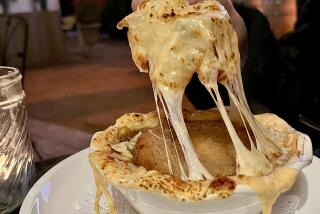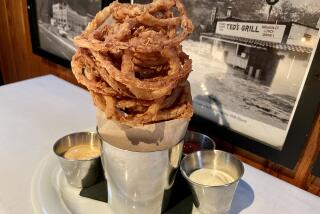IN THE KITCHEN : Jeepers, Weepers
- Share via
People have always had an attitude about onions. First, onions were part of the allium-based sniggering joke club--scorned because of their strong smell. Then they zoomed into the vegetable stratosphere with appellation-labeled super-onions getting their full 15 minutes of fame.
All too often, though, the problem is that they’re not even noticed. Onions are tossed off as culinary filler . . . forgotten . . . ignored.
But onions never go out of season (almost). They never go too high in price (though I probably would have said the same for iceberg lettuce not so long ago). And when they’re cooked, onions are among the sweetest vegetables on this green earth.
The best part is, the cheaper the onion, the better it tastes. Here’s the deal. An onion’s flavor is made up of basically two parts--the sweetness of the sugar stored in the root and the pungency of the sulfuric compounds that make you cry.
So-called sweet onions--the premium bulbs that can cost four or five times as much as the plain brown storage onions--actually aren’t higher in sugar at all. In fact, they have less. It’s just that they’re also lower in tear-causing compounds, so when eaten raw they taste sweeter.
But the pungency is heat-sensitive and goes away with cooking, while the sugar doesn’t. Anyone who has played with designer onions will attest that once they’re cooked, these high-priced darlings turn very plain-Jane.
That’s why, for cooking, you’re best off with the regular old five-pounds-for-a-$1 brown onions. When the pungency cooks off, there’s still enough sugar left to be interesting.
*
Getting these onions down to the caramelized stage is no big trick. The main thing it takes is a lot of time. Try to rush the process and you’ll wind up with scorched onions, which is no one’s idea of a good time. Start slow, and then cook even slower. Only when the onions are about to melt into a puree do you finally turn up the heat and start the browning.
What you’re left with is something quite sweet, especially if you cook onions at this time of year (onions are mainly harvested in the spring and fall and when fresh tend to be higher in sugar than onions that have been sitting around).
In fact, they can be so sweet that you need to be careful how you use them. The wrong flavors can be pretty jarring; you’ve probably noticed this at some of those restaurants where the chefs call caramelized onions a marmalade and serve it in all kinds of outlandish combinations.
Actually, you don’t even have to try to make this mistake. The first time I tried to make a caramelized onion pizza, I made it with four teaspoons of minced fresh rosemary. That was a little strong, so I cut it back by a teaspoon and liked the result much better. The rosemary should be barely detectable, more of an accent to the onion’s taste than an actual flavor of its own. With just the rosemary added, the caramelized onions make a nice condiment for roast meats, especially pork--though they cook down so far you’d have to peel and slice a whole sack to wind up with a decent portion.
*
Also go easy on the cheese. This amount of Parmigiano and Pecorino adds a nice complexity to the onions, but I think that much more might be a little . . . one hates to use the word disgusting about one’s own recipe.
If you like your pizzas with tons of cheese, add more mozzarella. And always add it right next to the crust, since it is the gooey glue that holds the whole thing together. Spread the onions first, and you’ll wind up with one of those hateful pizzas where the entire cheese mass slides off the crust in the first bite, leaving you with a molten, sticky bib.
CARAMELIZED ONION PIZZA
4 cups bread flour
1 envelope fast-rising dry yeast
Salt
Olive oil
1 1/3 to 1 1/2 cups warm water
3 pounds brown onions, sliced, about 4 large onions
4 cloves garlic, minced
1 tablespoon minced fresh rosemary
1/2 pound mozzarella, grated
1 cup mixture grated Parmigiano-Reggiano and Pecorino Romano, equal amounts
Freshly ground pepper
I’ve written about how to turn your home oven into a pizza oven before, but I cannot urge you strongly enough to try it for yourself. Preheat baking tiles in the oven and slide the raw dough directly onto them (a jerky push-pull does the trick). You’ll get a crust better than any but the best restaurants.
Combine flour, yeast, 2 teaspoons salt and 1 tablespoon olive oil in work bowl of food processor fitted with metal blade. Pulse to combine. With food processor running, begin pouring water through feed tube until dough mass forms that holds together and bumps around bowl on top of metal blade. Continue running 15 to 20 seconds, to knead dough.
Remove dough and continue kneading by hand, 4 to 5 turns, until dough is smooth and satiny. Divide into 4 pieces. Shape each piece into flat round. Cover loosely with plastic wrap. Set aside to rise.
Combine onions and 3 tablespoons olive oil in large saute pan. Place over low heat and cook until onions begin to soften, about 10 minutes. Add 1 teaspoon salt, stir and cover. Continue cooking over low heat, stirring occasionally, until onions are very soft, another 30 to 45 minutes.
Add half of minced garlic and raise heat to medium high. Cook, stirring frequently, until onions begin to caramelize, about 5 to 10 minutes. They will turn dark-brown but must not turn black. When onions start to caramelize, remove from heat. Add remaining garlic and rosemary. Set aside, stirring occasionally until pan is cool to keep from scorching.
Meanwhile, place oven rack lined with quarry tiles or pizza stone on lowest level and preheat oven to highest non-broiler temperature of about 500 to 550 degrees.
When ready to cook pizza, roll out 1 dough round as thin as possible. Dust wooden pizza paddle or back of rimless baking sheet with cornmeal. Place pizza crust on top and distribute 1/4 mozzarella evenly across top, stopping 1/2 inch short of rim. Distribute 1/4 of caramelized onions over that, spreading fairly even with back of spoon. Sprinkle over 1/4 of grated Parmigiano-Pecorino combination. Repeat with remaining dough rounds.
Slide pizzas into preheated oven and bake until bottom of crust browns and cheese begins to bubble and blister, about 7 to 10 minutes. Remove. Season to taste with salt and pepper. Cool 2 to 3 minutes to let cheese set before cutting into pieces.
Makes 4 pizzas, about 8 servings.
Each serving contains about:
495 calories; 964 mg sodium; 31 mg cholesterol; 18 grams fat; 63 grams carbohydrates; 21 grams protein; 1 gram fiber.
More to Read
Eat your way across L.A.
Get our weekly Tasting Notes newsletter for reviews, news and more.
You may occasionally receive promotional content from the Los Angeles Times.











